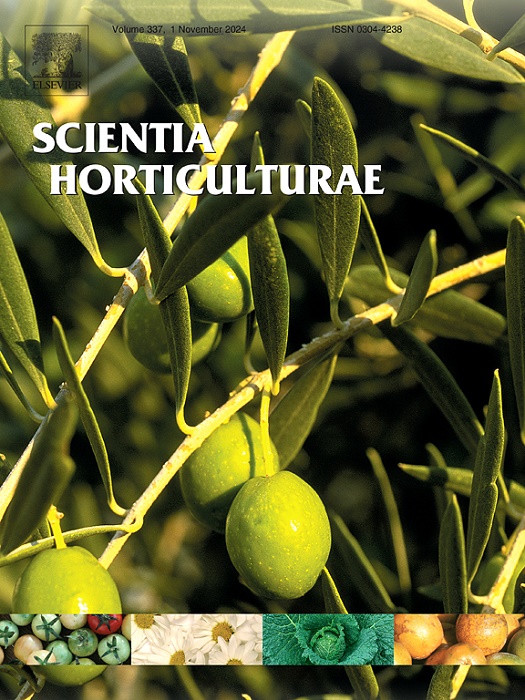油茶果实性状及籽油营养成分在发育和采后的变化
IF 3.9
2区 农林科学
Q1 HORTICULTURE
引用次数: 0
摘要
油茶。是中国独特而重要的食油作物。油桐的品质和高产与栽培、管理和后端加工储存密切相关。然而,国内外对油桐的生长发育、干燥处理和后端贮藏等方面的研究还不够全面。为此,研究了油油树果实生长和成熟过程中的表型特征,并探讨了室温干燥(SW)、热风干燥(RF, 65℃)、真空干燥(ZG, 50℃,0.6 Mpa)和冷冻干燥(LD) 4种不同干燥方法对油油树种子(COS)含油量的影响。同时,研究了油松仁油(COKO)在常温贮藏(SG)和4℃冷冻贮藏(LC)条件下主要成分和营养成分的变化。结果表明,油葵品种‘长林40’的果实生长发育呈s型曲线。随着果实成熟期的增加,含油量呈先上升后稳定的趋势,可溶性蛋白和淀粉含量呈上升趋势,可溶性糖含量在果实发育早期迅速上升,后期逐渐下降。真空干燥得到的油中角鲨烯的最高含量为80.578 μg/g。经RF处理的COS含油量为55.31%,显著高于其他处理。此外,还发现随着SG存放时间的延长,COKO的酸值和过氧化值显著升高,生育酚、角鲨烯、甾醇等营养物质显著降低,这与LC正好相反,说明LC可以减少贮藏过程中营养物质的流失。该研究可为油桐田间管理、干燥方法筛选及后续贮藏提供理论依据。本文章由计算机程序翻译,如有差异,请以英文原文为准。

Variation of Camellia oleifera fruit traits and nutritional constituents in seed oil during development and post-harvest
Camellia oleifera Abel. is a unique and important edible oil crop in China. The quality and high yield of C. oleifera are closely related to cultivation, management and back-end processing and storage. However, studies on the growth and development, drying treatment and back-end storage of C. oleifera are not comprehensive enough. Therefore, the phenotypic characteristics of C.oleifera fruits during growth and ripening were studied and the effects of four different drying methods including room temperature drying (SW), hot air drying (RF, 65 °C), vacuum drying (ZG, 50 °C, 0.6 Mpa) and freeze drying (LD) on the oil content of C.oleifera seeds (COS) were discussed. At the same time, the changes of the main components and nutrients of C.oleifera kernel oil (COKO) under room temperature storage (SG) and 4 °C frozen storage (LC) were also investigated. The results of the study showed that C. oleifera cultivar ‘Changlin40’ exhibited an S-shaped curve in fruit growth and development. In addition, the oil content initially increased and then remained stable, and the soluble protein and starch contents increased with increasing fruit maturity, but the soluble sugar content increased rapidly at the early stage of fruit development and gradually decreased at the later stage. The maximum content of squalene in the oil obtained by vacuum drying was 80.578 μg/g. The oil content of COS treated by RF was 55.31%, significantly higher than the other treatments. In addition, it was also found that with increasing duration of SG, the acid and peroxide values of COKO increased significantly and the nutrients such as tocopherol, squalene and sterol decreased significantly, which was exactly the opposite of LC, indicating that LC could reduce the loss of nutrients during storage. This study can provide a theoretical basis for field management, screening of drying methods and subsequent storage of C. oleifera.
求助全文
通过发布文献求助,成功后即可免费获取论文全文。
去求助
来源期刊

Scientia Horticulturae
农林科学-园艺
CiteScore
8.60
自引率
4.70%
发文量
796
审稿时长
47 days
期刊介绍:
Scientia Horticulturae is an international journal publishing research related to horticultural crops. Articles in the journal deal with open or protected production of vegetables, fruits, edible fungi and ornamentals under temperate, subtropical and tropical conditions. Papers in related areas (biochemistry, micropropagation, soil science, plant breeding, plant physiology, phytopathology, etc.) are considered, if they contain information of direct significance to horticulture. Papers on the technical aspects of horticulture (engineering, crop processing, storage, transport etc.) are accepted for publication only if they relate directly to the living product. In the case of plantation crops, those yielding a product that may be used fresh (e.g. tropical vegetables, citrus, bananas, and other fruits) will be considered, while those papers describing the processing of the product (e.g. rubber, tobacco, and quinine) will not. The scope of the journal includes all horticultural crops but does not include speciality crops such as, medicinal crops or forestry crops, such as bamboo. Basic molecular studies without any direct application in horticulture will not be considered for this journal.
 求助内容:
求助内容: 应助结果提醒方式:
应助结果提醒方式:


